Land Cover Change in the Central Region of the Lower Yangtze River Based on Landsat Imagery and the Google Earth Engine: A Case Study in Nanjing, China
Abstract
1. Introduction
2. Materials and Methods
2.1. Study Area
2.2. Data Acquisition and Processing
2.3. Methodology
2.3.1. Technical Process
- Based on the GEE platform, six quality composites were acquired via image date filtering, cloud masking, and mosaicking, spanning from 1987 to 2017, as described in Section 2.2.
- Normalized difference indexes were utilized in the training-sample selection. With the support of multisource land-cover products, training and verification sample points were carefully deployed according to the “complete consistency” and “temporal stability” principles. The land-cover attributes were then extracted for the samples.
- The RF model was applied for extracting land-cover types based on Landsat satellite images and auxiliary data with the selected training samples. The mapping of the land cover in Nanjing was performed by applying the training rules.
- The mechanisms of land-cover change with infrastructure construction and human activities in this area were explored with multiple stepwise regression modeling, combined with climate change and social development factors.
2.3.2. Training-Sample Selection
2.3.3. Landsat Classification and Accuracy Assessment
2.3.4. Multiple Linear Stepwise Regression Analysis
3. Results
3.1. Accuracy Assessment
3.2. Spatial Distribution of Land Cover
3.3. Spatiotemporal Changes of Land Cover
4. Discussion
4.1. Land-Cover Changes Influenced by Natural and Human Factors
4.2. Advantages and Limitations of Using the GEE
5. Conclusions
Supplementary Materials
Author Contributions
Funding
Acknowledgments
Conflicts of Interest
References
- Gottmann, J. Megalopolis or the urbanization of the northeastern seaboard. Econ. Geogr. 1957, 33, 189–200. [Google Scholar] [CrossRef]
- Fang, C.; Yu, D. Urban agglomeration: An evolving concept of an emerging phenomenon. Landsc. Urban Plan. 2017, 162, 126–136. [Google Scholar] [CrossRef]
- Shu, C.; Xie, H.; Jiang, J.; Chen, Q. Is Urban Land Development Driven by Economic Development or Fiscal Revenue Stimuli in China? Land Use Policy 2018, 77, 107–115. [Google Scholar] [CrossRef]
- Chen, Y.; Chen, Z.; Xu, G.; Tian, Z. Built-up land efficiency in urban China: Insights from the General Land Use Plan (2006–2020). Habitat Int. 2016, 51, 31–38. [Google Scholar] [CrossRef]
- Lu, S.; Bao, H.; Pan, H. U rban water security evaluation based on similarity measure model of Vague sets. Int. J. Hydrog. Energy 2016, 41, 15944–15950. [Google Scholar] [CrossRef]
- Midekisa, A.; Holl, F.; Savory, D.J.; Andrade-Pacheco, R.; Gething, P.W.; Bennett, A.; Sturrock, H.J.W. Mapping land cover change over continental Africa using Landsat and Google Earth Engine cloud computing. PLoS ONE 2017, 12, e0184926. [Google Scholar] [CrossRef] [PubMed]
- Masek, J.G.; Huang, C.; Wolfe, R.; Cohen, W.; Hall, F.; Kutler, J.; Nelson, P. North American forest disturbance mapped from a decadal Landsat record. Remote Sens. Environ. 2008, 112, 2914–2926. [Google Scholar] [CrossRef]
- Wang, C.; Jia, M.; Chen, N.; Wang, W. Long-Term Surface Water Dynamics Analysis Based on Landsat Imagery and the Google Earth Engine Platform: A Case Study in the Middle Yangtze River Basin. Remote Sens. 2018, 10, 1635. [Google Scholar] [CrossRef]
- Goward, S.; Arvidson, T.; Williams, D.; Faundeen, J.; Irons, J.; Franks, S. Historical Record of Landsat Global Coverage: Mission Operations, NSLRSDA, and International Cooperator Stations. Photogramm. Eng. Remote Sens. 2006, 72, 1155–1169. [Google Scholar] [CrossRef]
- Fuller, R.M.; Groom, G.B.; Jones, A.R. The Land Cover Map of Great Britain: An Automated Classification of Landsat Thematic Mapper Data. Photogramm. Eng. Remote Sens. 1994, 60, 553–562. [Google Scholar]
- Vogelmann, J.E.; Howard, S.M.; Yang, L.; Larson, C.R.; Wylie, B.K.; Van Driel, J.N. Completion of the 1990’s National Land Cover Data Set for the conterminous United States. Photogramm. Eng. Remote Sens. 2001, 67, 650–662. [Google Scholar]
- Woodcock, C.E.; Macomber, S.A.; Pax-Lenney, M.; Cohen, W.B. Monitoring large areas for forest change using Landsat_ Generalization across space, time and Landsat sensors. Remote Sens. Environ. 2001, 78, 194–203. [Google Scholar] [CrossRef]
- Cohen, W.B.; Goward, S.N. Landsat’s Role in Ecological Applications of Remote Sensing. BioScience 2004, 54, 535–545. [Google Scholar] [CrossRef]
- Wulder, M.A.; White, J.C.; Goward, S.N.; Masek, J.G.; Irons, J.R.; Herold, M.; Cohen, W.B.; Loveland, T.R.; Woodcock, C.E. Landsat continuity: Issues and opportunities for land cover monitoring. Remote Sens. Environ. 2008, 112, 955–969. [Google Scholar] [CrossRef]
- Chander, G.; Markham, B.L.; Helder, D.L. Summary of current radiometric calibration coefficients for Landsat MSS, TM, ETM+, and EO-1 ALI sensors. Remote Sens. Environ. 2009, 113, 893–903. [Google Scholar] [CrossRef]
- Angel, S.; Parent, J.; Civco, D.L.; Blei, A.; Potere, D. The dimensions of global urban expansion: Estimates and projections for all countries, 2000–2050. Prog. Plan. 2011, 75, 53–107. [Google Scholar] [CrossRef]
- Schneider, A. Monitoring land cover change in urban and peri-urban areas using dense time stacks of Landsat satellite data and a data mining approach. Remote Sens. Environ. 2012, 124, 689–704. [Google Scholar] [CrossRef]
- Kelsey, E.N.; Grant, E.G.; Nikolay, I.S.; Ryan, N.E.; Dmitry, A.S. Land Cover Change in the Lower Yenisei River Using Dense Stacking of Landsat Imagery in Google Earth Engine. Remote Sens. 2018, 10, 1226. [Google Scholar] [CrossRef]
- Gómez, C.; White, J.C.; Wulder, M.A. Optical remotely sensed time series data for land cover classification: A review. ISPRS J. Photogramm. Remote Sens. 2016, 116, 55–72. [Google Scholar] [CrossRef]
- Hu, Y.; Dong, Y.; Batunacun. An automatic approach for land-change detection and land updates based on integrated NDVI timing analysis and the CVAPS method with GEE support. ISPRS J. Photogramm. Remote Sens. 2018, 146, 347–359. [Google Scholar] [CrossRef]
- Weng, Q. Remote sensing of impervious surfaces in the urban areas: Requirements, methods, and trends. Remote Sens. Environ. 2012, 117, 34–49. [Google Scholar] [CrossRef]
- Ridd, M.K. Exploring a V-I-S (vegetation-impervious surface-soil) model for urban ecosystem analysis through remote sensing: Comparative anatomy for cities. Int. J. Remote Sens. 2007, 16, 2165–2185. [Google Scholar] [CrossRef]
- Wu, C. Normalized spectral mixture analysis for monitoring urban composition using ETM+ imagery. Remote Sens. Environ. 2004, 93, 480–492. [Google Scholar] [CrossRef]
- Earth Engine Code Editor. Available online: https://code.earthengine.google.com (accessed on 21 October 2019).
- Kumar, L.; Mutanga, O. Google Earth Engine Applications Since Inception: Usage, Trends, and Potential. Remote Sens. 2018, 10, 1509. [Google Scholar] [CrossRef]
- Johansen, K.; Phinn, S.; Taylor, M. Mapping woody vegetation clearing in Queensland, Australia from Landsat imagery using the Google Earth Engine. Remote Sens. Appl. Soc. Environ. 2015, 1, 36–49. [Google Scholar] [CrossRef]
- Kontgis, C.; Schneider, A.; Ozdogan, M. Mapping rice paddy extent and intensification in the Vietnamese Mekong River Delta with dense time stacks of Landsat data. Remote Sens. Environ. 2015, 169, 255–269. [Google Scholar] [CrossRef]
- Chen, B.; Xiao, X.; Li, X.; Pan, L.; Doughty, R.; Ma, J.; Dong, J.; Qin, Y.; Zhao, B.; Wu, Z.; et al. A mangrove forest map of China in 2015: Analysis of time series Landsat 7/8 and Sentinel-1A imagery in Google Earth Engine cloud computing platform. ISPRS J. Photogramm. Remote Sens. 2017, 131, 104–120. [Google Scholar] [CrossRef]
- Patel, N.N.; Angiuli, E.; Gamba, P.; Gaughan, A.; Lisini, G.; Stevens, F.R.; Tatem, A.J.; Trianni, G. Multitemporal settlement and population mapping from Landsat using Google Earth Engine. Int. J. Appl. Earth Obs. Geoinf. 2015, 35, 199–208. [Google Scholar] [CrossRef]
- Goldblatt, R.; You, W.; Hanson, G.; Khandelwal, A. Detecting the Boundaries of Urban Areas in India: A Dataset for Pixel-Based Image Classification in Google Earth Engine. Remote Sens. 2016, 8, 634. [Google Scholar] [CrossRef]
- Tucker, C.J. Red and photographic infrared linear combinations for monitoring vegetation. Remote Sens. Environ. 1979, 8, 127–150. [Google Scholar] [CrossRef]
- McFeeters, S.K. The use of the Normalized Difference Water Index (NDWI) in the delineation of open water features. Int. J. Remote Sens. 1996, 17, 1425–1432. [Google Scholar] [CrossRef]
- Jarvis, A.; Reuter, H.I.; Nelson, A.; Guevara, E. Hole-Filled SRTM for the Globe Version 4. 2008. Available online: http://srtm.csi.cgiar.org (accessed on 18 December 2019).
- Amaral, S.; Monteiro, A.M.V.; Camara, G.; Quintanilha, J.A. DMSP/OLS night-time light imagery for urban population estimates in the Brazilian Amazon. Int. J. Remote Sens. 2007, 27, 855–870. [Google Scholar] [CrossRef]
- Abatzoglou, J.T.; Dobrowski, S.Z.; Parks, S.A.; Hegewisch, K.C. TerraClimate, a high-resolution global dataset of monthly climate and climatic water balance from 1958–2015. Sci. Data 2018, 5, 170191. [Google Scholar] [CrossRef]
- Okoro, S.U.; Schickhoff, U.; Böhner, J.; Schneider, U.A. A novel approach in monitoring land-cover change in the tropics: Oil palm cultivation in the Niger Delta, Nigeria. DIE ERDE-J. Geog. Soc. Berl. 2016, 147, 40–52. [Google Scholar] [CrossRef]
- Vleeshouwer, J.; Car, N.J.; Hornbuckle, J. A Cotton Irrigator’s Decision Support System and Benchmarking Tool Using National, Regional and Local Data; Springer International Publishing: Cham, Switzerland, 2015; pp. 187–195. [Google Scholar]
- Xu, H. A study on information extraction of water body with the modified normalized difference water index (mndwi). J. Romote Sens. 2005, 5, 589–595. [Google Scholar]
- Stuhler, S.C.; Leiterer, R.; Joerg, P.C.; Wulf, H.; Schaepman, M.E. Generating a Cloud-Free, Homogeneous Landsat-8 Moasaic of Switzerland Using Google Earth Engine. Available online: https://www.researchgate.net/publication/302589628_Generating_a_cloud-free_homogeneous_Landsat-8_mosaic_of_Switzerland_using_Google_Earth_Engine (accessed on 7 November 2019).
- Beckschäfer, P. Obtaining rubber plantation age information from very dense Landsat TM & ETM + time series data and pixel-based image compositing. Remote Sens. Environ. 2017, 196, 89–100. [Google Scholar] [CrossRef]
- Pekel, J.F.; Cottam, A.; Gorelick, N.; Belward, A.S. High-resolution mapping of global surface water and its long-term changes. Nature 2016, 540, 418–422. [Google Scholar] [CrossRef]
- Breiman, L. Random Forests. Mach. Learn. 2001, 45, 5–32. [Google Scholar] [CrossRef]
- Yu, X.; Hyyppä, J.; Vastaranta, M.; Holopainen, M.; Viitala, R. Predicting individual tree attributes from airborne laser point clouds based on the random forests technique. ISPRS J. Photogramm. Remote Sens. 2011, 66, 28–37. [Google Scholar] [CrossRef]
- Chen, M.; Rowland, J.C.; Wilson, C.J.; Altmann, G.L.; Brumby, S.P. The Importance of Natural Variability in Lake Areas on the Detection of Permafrost Degradation: A Case Study in the Yukon Flats, Alaska. Permafr. Periglac. Process. 2013, 24, 224–240. [Google Scholar] [CrossRef]
- Wang, Q.; Yang, Y.; Chen, L. Analysis on the change of water distribution pattern and itsinfluence factors in Nanjing City during 1990–2018. China Agric. Inf. 2019, 31, 110–119. [Google Scholar] [CrossRef]
- Zhou, S.; Zhu, Q.; Guo, Q. Variation of land-use structure in Nanjing over the last decade. Soils 2005, 37, 394–399. [Google Scholar]
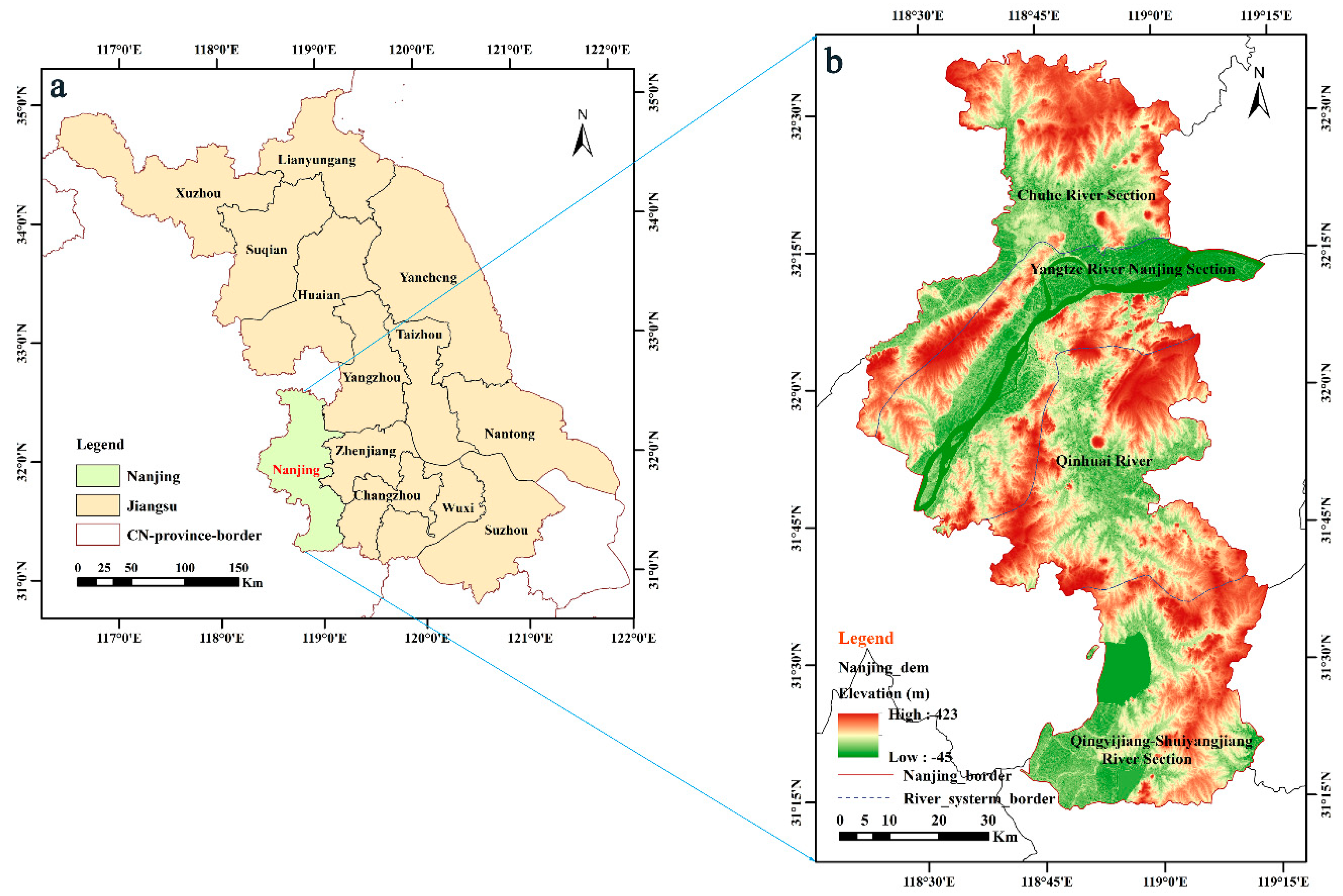
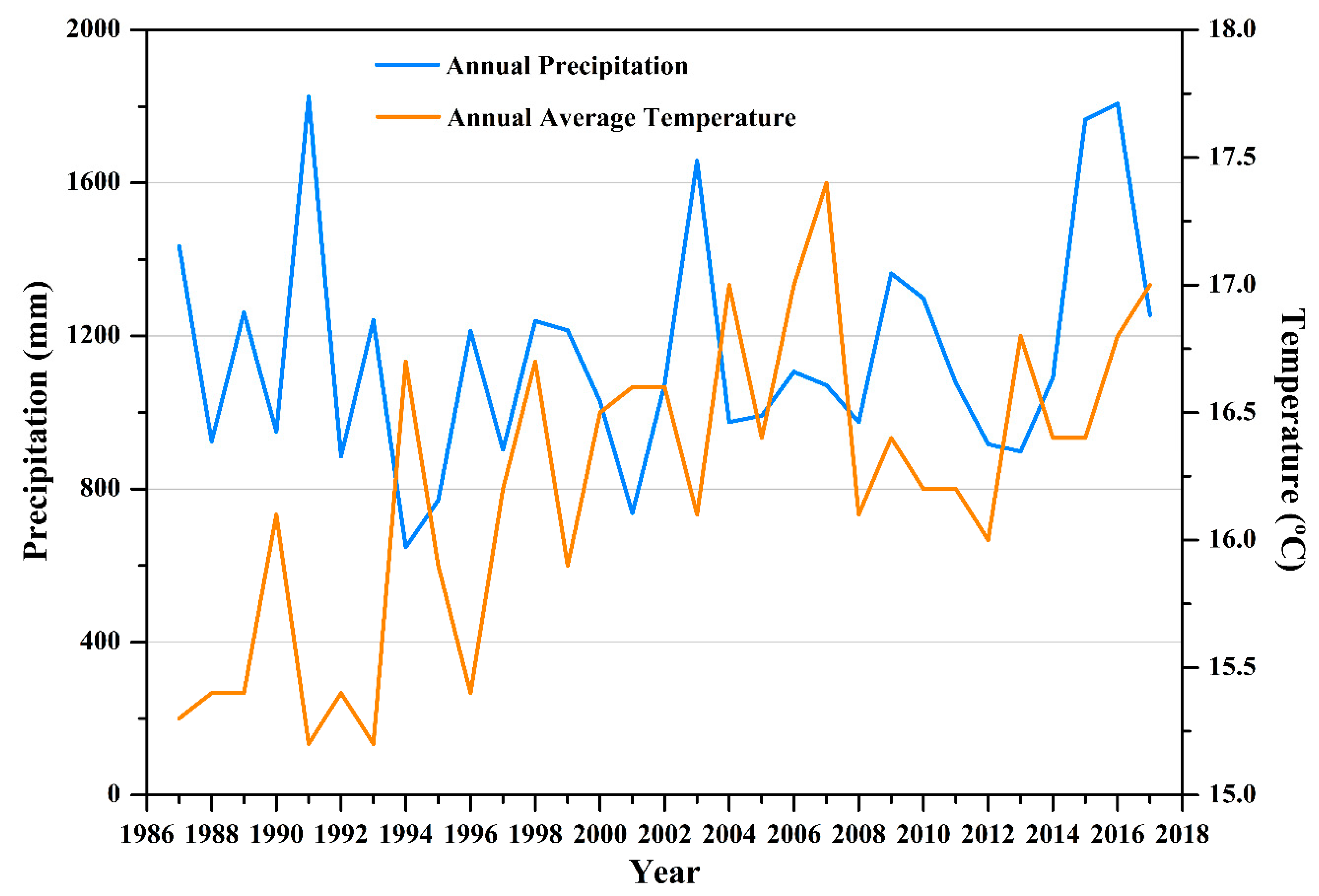
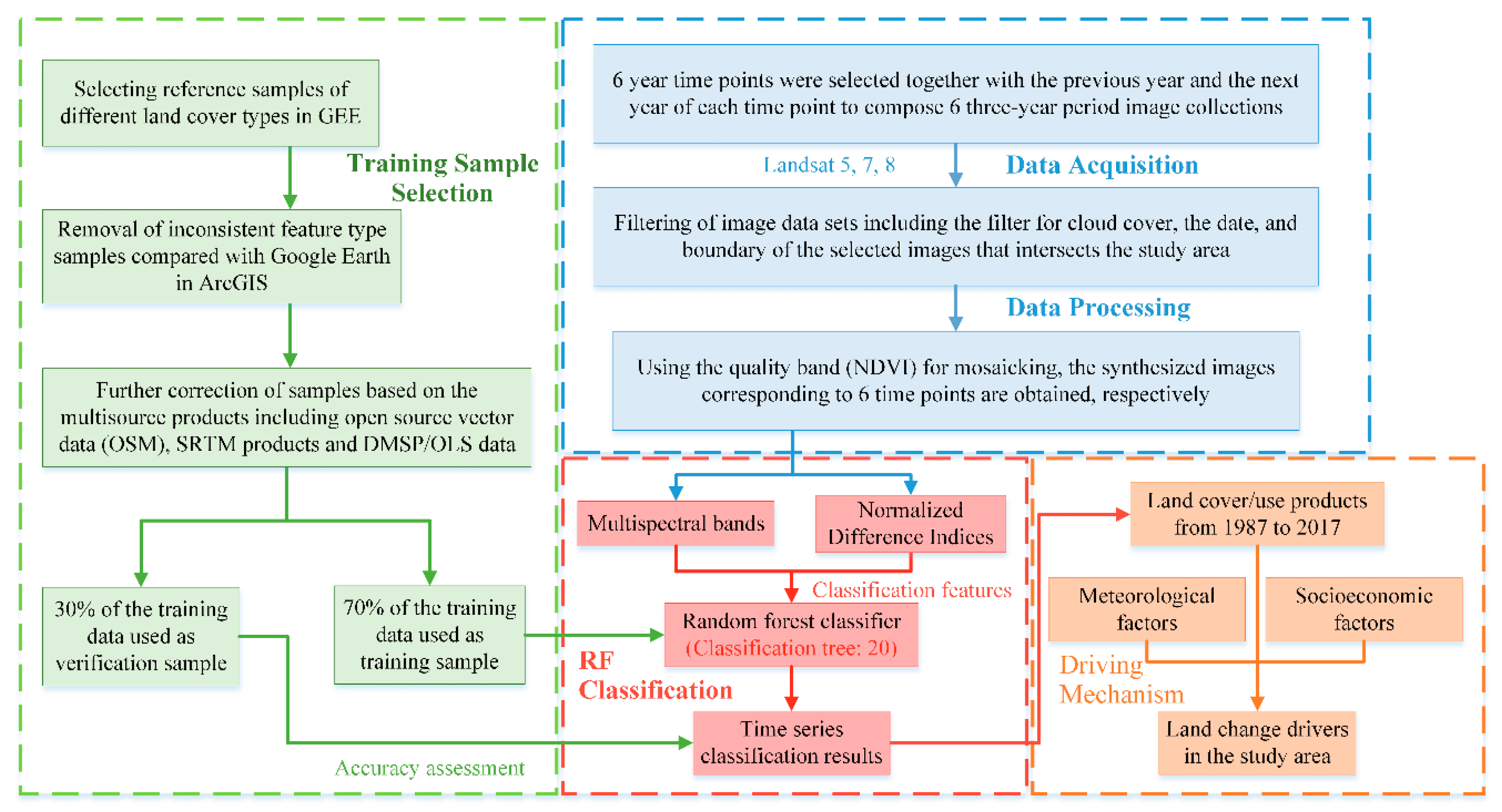


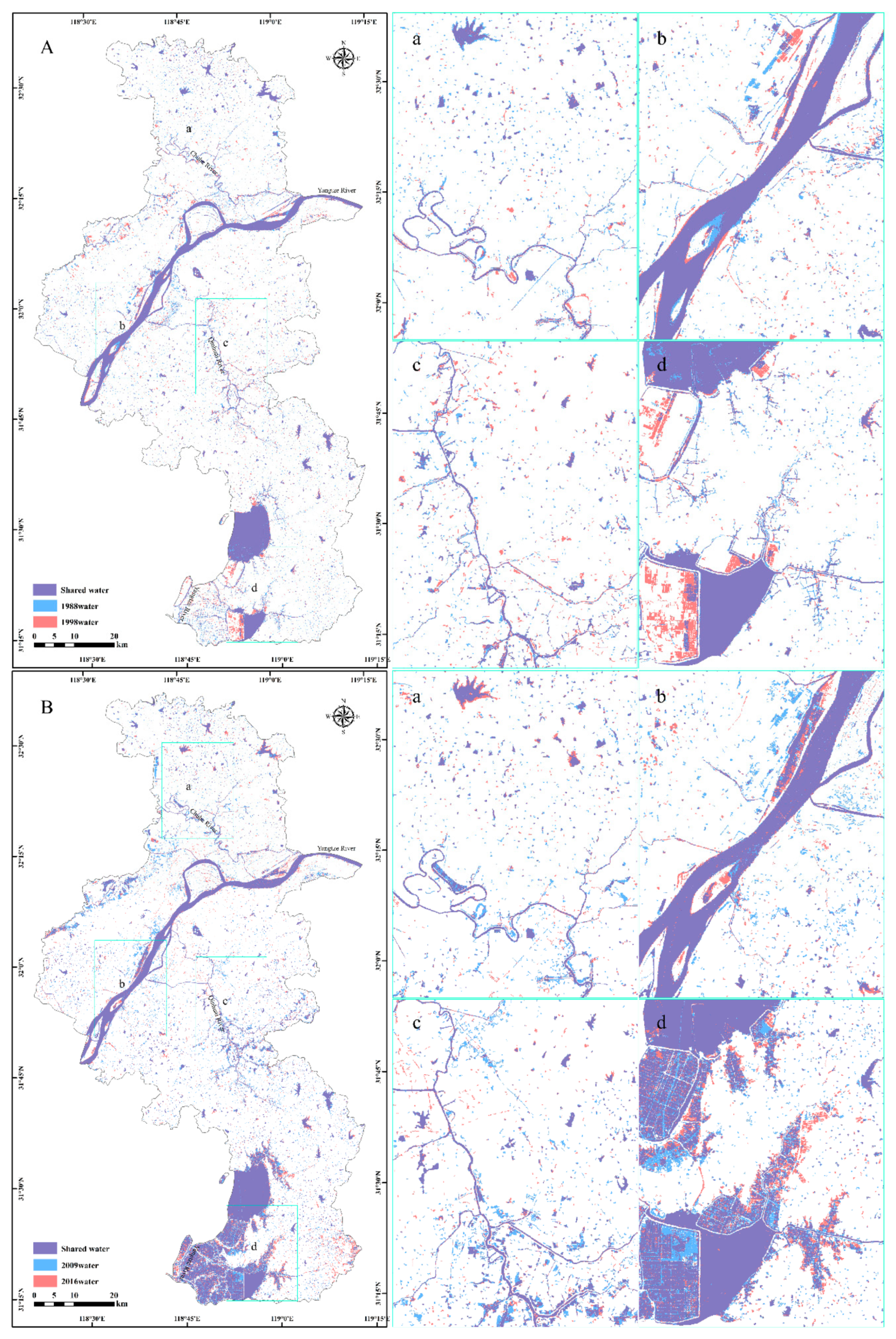

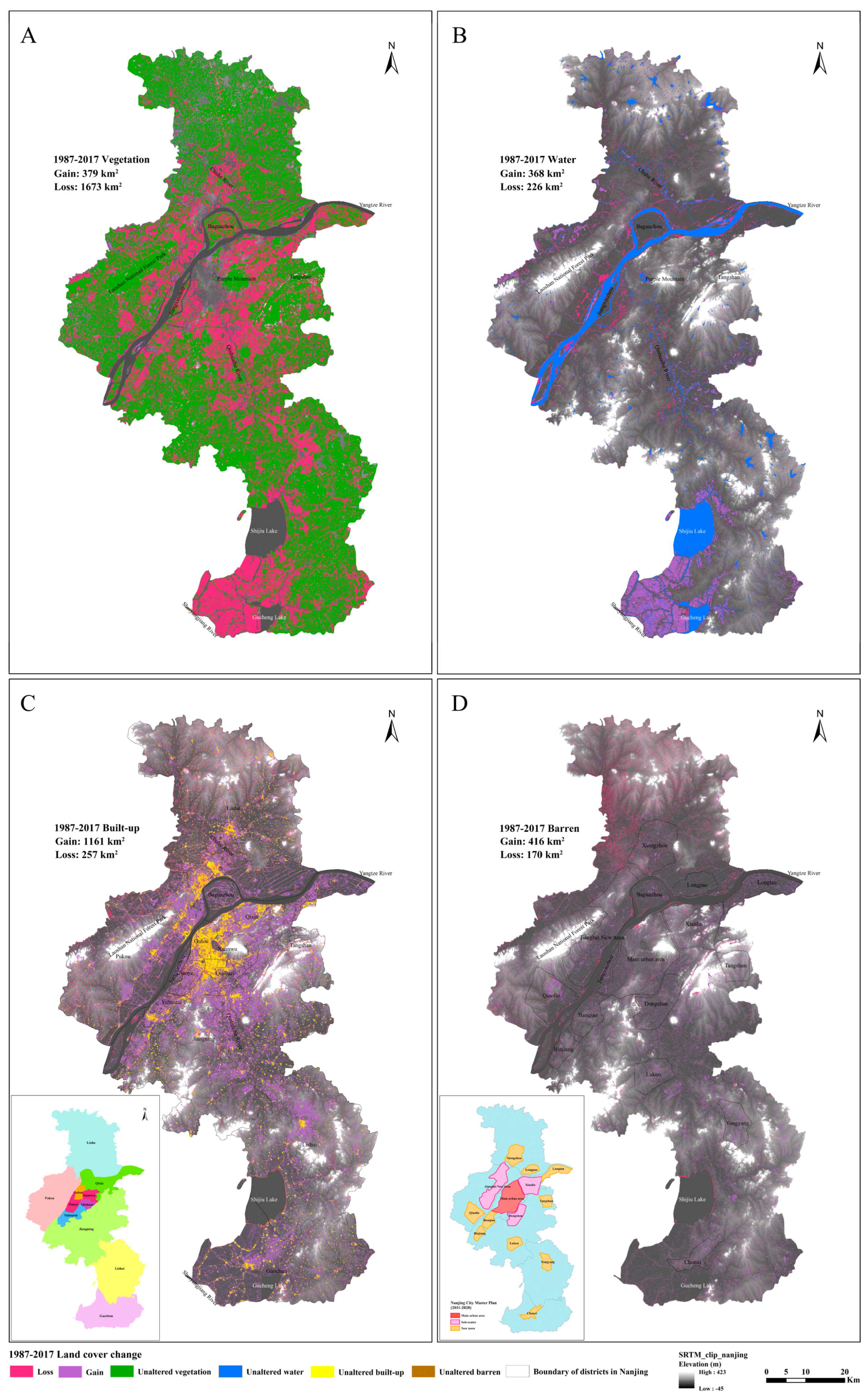
| Satellite Sensor | Three-Year Period | Date Frame | Image Count |
|---|---|---|---|
| Landsat 5 | 1987–1989 | 1 Mar to 15 Jun and 16 Jul to 31 Nov | 36 |
| Landsat 5 | 1992–1994 | 1 Mar to 15 Jun and 16 Jul to 31 Nov | 39 |
| Landsat 5 | 1997–1999 | 1 Mar to 15 Jun and 16 Jul to 31 Nov | 26 |
| Landsat 7 | 2003–2005 | 1 Mar to 15 Jun and 16 Jul to 31 Nov | 40 |
| Landsat 7 | 2008–2010 | 1 Mar to 15 Jun and 16 Jul to 31 Nov | 52 |
| Landsat 8 | 2015–2017 | 1 Mar to 15 Jun and 16 Jul to 31 Nov | 30 |
| Three-Year Period | Accuracy | Surface Water | Vegetation | Built-Up Area | Barren |
|---|---|---|---|---|---|
| 1987–1989 | User’s | 0.95 ± 0.02 | 0.99 ± 0.01 | 0.85 ± 0.02 | 0.84 ± 0.04 |
| Producer’s | 0.95 ± 0.01 | 1 ± 0.00 | 0.92 ± 0.04 | 0.65 ± 0.04 | |
| Overall | 0.90 ± 0.01 | ||||
| Kappa | 0.86 ± 0.01 | ||||
| 1992–1994 | User’s | 0.95 ± 0.02 | 0.98 ± 0.01 | 0.84 ± 0.02 | 0.85 ± 0.01 |
| Producer’s | 0.95 ± 0.01 | 1 ± 0.00 | 0.90 ± 0.01 | 0.75 ± 0.03 | |
| Overall | 0.89 ± 0.01 | ||||
| Kappa | 0.85 ± 0.02 | ||||
| 1997–1999 | User’s | 0.95 ± 0.02 | 0.99 ± 0.00 | 0.85 ± 0.00 | 0.86 ± 0.01 |
| Producer’s | 0.96 ± 0.02 | 1 ± 0.00 | 0.91 ± 0.01 | 0.70 ± 0.06 | |
| Overall | 0.90 ± 0.02 | ||||
| Kappa | 0.87 ± 0.01 | ||||
| 2003–2005 | User’s | 0.99 ± 0.01 | 0.99 ± 0.01 | 0.82 ± 0.03 | 0.83 ± 0.04 |
| Producer’s | 0.98 ± 0.01 | 0.99 ± 0.01 | 0.84 ± 0.01 | 0.79 ± 0.04 | |
| Overall | 0.89 ± 0.01 | ||||
| Kappa | 0.85 ± 0.02 | ||||
| 2008–2010 | User’s | 0.99 ± 0.01 | 0.97 ± 0.02 | 0.84 ± 0.02 | 0.83 ± 0.01 |
| Producer’s | 0.98 ± 0.02 | 0.97 ± 0.01 | 0.84 ± 0.04 | 0.82 ± 0.04 | |
| Overall | 0.90 ± 0.005 | ||||
| Kappa | 0.87 ± 0.005 | ||||
| 2015–2017 | User’s | 0.99 ± 0.01 | 0.98 ± 0.01 | 0.78 ± 0.05 | 0.84 ± 0.03 |
| Producer’s | 1 ± 0.00 | 0.97 ± 0.00 | 0.84 ± 0.04 | 0.76 ± 0.06 | |
| Overall | 0.90 ± 0.02 | ||||
| Kappa | 0.86 ± 0.02 | ||||
| Period | Land Area | Water | Vegetation | Built-Up Area | Barren |
|---|---|---|---|---|---|
| 1987–1989 | Area (km2) | 728.01 | 5107.89 | 537.85 | 222.08 |
| Percentage | 11.04 | 77.44 | 8.15 | 3.37 | |
| Change rate (%) | - | - | - | - | |
| 1997–1999 | Area (km2) | 711.48 | 4684.17 | 923.05 | 277.12 |
| Percentage | 10.79 | 71.02 | 13.99 | 4.20 | |
| Change rate (%) | −2.27 | −8.30 | 71.62 | 24.78 | |
| 2008–2010 | Area (km2) | 993.10 | 4044.74 | 1212.81 | 334.42 |
| Percentage | 15.06 | 61.32 | 18.39 | 5.07 | |
| Change rate (%) | 39.58 | −13.65 | 31.39 | 20.68 | |
| 2015–2017 | Area (km2) | 858.58 | 3802.19 | 1500.54 | 432.72 |
| Percentage | 13.02 | 57.66 | 22.76 | 6.56 | |
| Change rate (%) | −13.55 | −6.00 | 23.72 | 29.39 |
© 2020 by the authors. Licensee MDPI, Basel, Switzerland. This article is an open access article distributed under the terms and conditions of the Creative Commons Attribution (CC BY) license (http://creativecommons.org/licenses/by/4.0/).
Share and Cite
Zhang, D.-D.; Zhang, L. Land Cover Change in the Central Region of the Lower Yangtze River Based on Landsat Imagery and the Google Earth Engine: A Case Study in Nanjing, China. Sensors 2020, 20, 2091. https://doi.org/10.3390/s20072091
Zhang D-D, Zhang L. Land Cover Change in the Central Region of the Lower Yangtze River Based on Landsat Imagery and the Google Earth Engine: A Case Study in Nanjing, China. Sensors. 2020; 20(7):2091. https://doi.org/10.3390/s20072091
Chicago/Turabian StyleZhang, Dong-Dong, and Lei Zhang. 2020. "Land Cover Change in the Central Region of the Lower Yangtze River Based on Landsat Imagery and the Google Earth Engine: A Case Study in Nanjing, China" Sensors 20, no. 7: 2091. https://doi.org/10.3390/s20072091
APA StyleZhang, D.-D., & Zhang, L. (2020). Land Cover Change in the Central Region of the Lower Yangtze River Based on Landsat Imagery and the Google Earth Engine: A Case Study in Nanjing, China. Sensors, 20(7), 2091. https://doi.org/10.3390/s20072091






